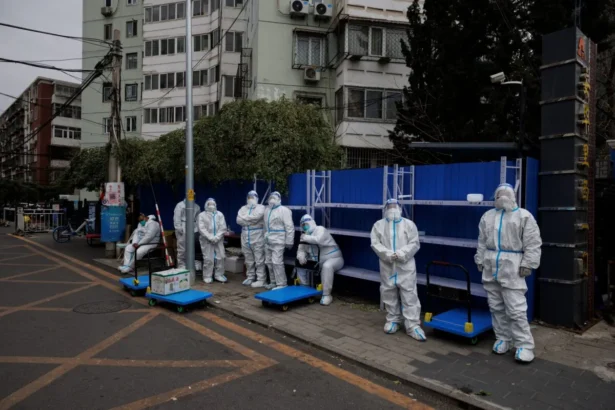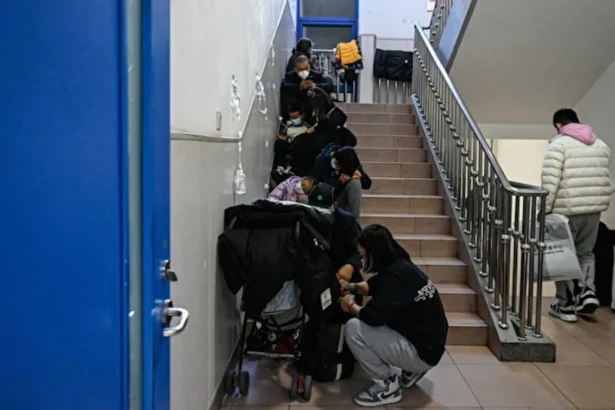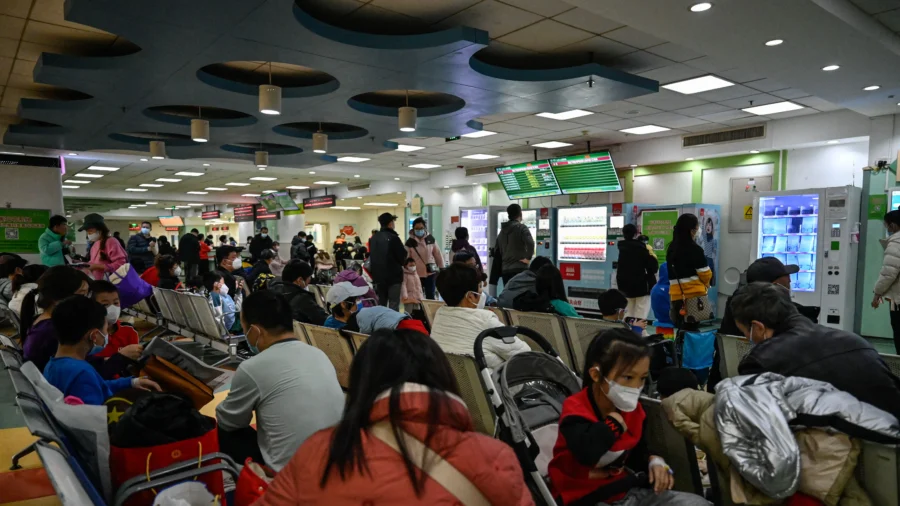As a mysterious wave of child pneumonia surges through China and spreads to adults, various explanations for the outbreak from state health authorities can’t quell suspicions among the public that it’s COVID-19 caused by mutated viral strains.
Initially, the authorities denied any “unusual or novel pathogens or unusual clinical presentations” in response to the World Health Organization’s official request for data regarding the child pneumonia outbreak.
But more recently, the ruling Chinese Communist Party’s (CCP) National Health Commission warned late last week that the spread of several known respiratory pathogens could converge into a major outbreak between now and next spring.
At a Nov. 26 press briefing on the illness outbreak, National Health Commission spokesperson Mi Feng said flu, adenovirus, respiratory syncytial virus (RSV), and respiratory syncytial virus have surpassed mycoplasma in causing the surge in acute respiratory illnesses, leaving out the SARS-CoV-2 virus that causes COVID-19.
However, at the same press briefing, when answering a reporter’s question, Wang Huaqing, chief expert with the Immunization Program of China Centers for Disease Control and Prevention, said that there are other pathogens besides influenza that are causing respiratory illnesses in different age groups ranging from 1-60 year old, including the SARS-CoV-2 virus.
He said that in children aged 1-4, “in addition to influenza, there are also RSV that cause common colds”; influenza, mycoplasma, and adenovirus are in children aged 5-14 years old. For those aged 15-59, “in addition to influenza viruses, RSV, and new coronavirus pathogens [SARS-CoV-2 virus] have been detected; ordinary coronaviruses account for a relatively large proportion of [infections in] people over the age of 60.”
Meanwhile, Wang Quanyi, deputy director of the Beijing Center for Disease Control and Prevention and chief expert in epidemiology, said that in Beijing, mycoplasma pneumonia is no longer the leading cause of pediatric hospitalization. The top three causes are influenza, adenovirus, and RSV.
No Effective Drugs
Despite the official claim of the known pathogens behind the nationwide acute respiratory illnesses outbreak, Chinese health experts admitted that there’s no effective medicine to treat them.
Official Chinese media reported on Nov. 27 that many Chinese clinical infectious disease experts said there are no effective drugs for “upper respiratory tract infections at the moment.”
Shang Yunxiao, director of the Department of Pediatric Respiratory Medicine at Shengjing Hospital, affiliated with China Medical University, told the media that there are currently no effective anti-respiratory syncytial virus drugs, and there is still no syncytial virus vaccine approved for use in China. Adenovirus pneumonia is a type of pneumonia that immunocompromised adults and children are susceptible to.
The Shenzhen Health Commission posted on its official account on the Chinese social media platform Weibo on Nov. 29, “There is no specific cure for respiratory syncytial virus! No vaccine! It’s 2.5 times more contagious than the flu! It’s so difficult for parents this time around. Mycoplasma pneumonia has just subsided, influenza, norovirus, and COVID-19 are coming together again, and RSV has also joined in.”
Still COVID-19
The Chinese public has been suspecting the “undiagnosed pneumonia,” which the authorities have called “mycoplasma pneumonia,” that suddenly spiked in children since mid-October, is COVID-19 caused by a mutated strain of the SARS-CoV-2 virus.
Yu Changping, an expert in severe respiratory infections at Wuhan University Renmin Hospital with over 3 million followers on social media, recently posted on his Weibo account: “From October to November, mycoplasma pneumonia infection was prevalent across China, accounting for the dominant position in respiratory infectious diseases. Many hospitals’ pediatrics are overcrowded, many adults are also infected, and many have pneumonia… It’s also accompanied by a small number of COVID-19 infections.”

Since the mysterious pneumonia is very contagious, authorities in Beijing, Shanxi, Hebei, and other places have issued notices asking infected teachers and students to stay at home.
Some schools in Guangdong and Jiangsu provinces have suspended classes, requiring the infected to rest at home and avoiding repeated medical visits. Chinese medical experts also recommend that schools switch to online classes.
A video of “Big Whites” from a local emergency rescue center disinfecting schools in Sanhe City in Hebei Province went viral on social media, reminiscent of the COVID-19 pandemic. “Big Whites” refer to an army of COVID-19 prevention workers known for their white bulky hazmat suits during the CCP’s draconian lockdowns. They were dismissed after the regime suddenly abandoned COVID-19 control measures last December.

Scientists Skeptical
The WHO echoed the CCP’s explanation saying last week that common winter infections are behind the spike in hospitalizations. A surge of infections in respiratory disease was expected in the country this winter, as it’s the first winter after the regime removed COVID-19 restrictions since the pandemic began in 2020.
However, some epidemiologists have found the current outbreak in China to be unusual, as pointed out in the science publication Nature.
“When COVID-19 restrictions were eased in other countries, influenza and respiratory syncytial virus (RSV) drove most spikes in illness,” the article says.
“The Chinese wave of illness differs from that seen in other countries. Some nations grappled with flu and RSV infections during their post-COVID winter surges, but in China, M. pneumoniae infections have been common. This is surprising because bacterial infections are often opportunistic and take hold after viral infections,” said Benjamin Cowling, an epidemiologist at the University of Hong Kong.
Sean Lin, an assistant professor in the Biomedical Science Department at Feitian College and a former U.S. Army microbiologist, told The Epoch Times earlier this month that if the outbreaks were really of mycoplasma pneumonia, patients would respond to known treatments.
“It’s not difficult to control mycoplasma pneumonia with antibiotics; it can’t be that the medicine does not work,” he said. “It may be a new variant of COVID-19, and a comprehensive attack by more than two viruses and bacteria, [that] cannot be ruled out.”

“In fact, the COVID-19 epidemic has never left China. But the CCP authorities don’t dare to mention it anymore, so they used ‘H1N1’ flu or ‘mycoplasma pneumonia’ to cover it up.”
The Chinese health authorities have also claimed that the strain of mycoplasma has developed high drug resistance in China. However, according to media reports and posts on social media, doctors in China said they have tried all kinds of antibiotics and other drugs known to treat mycoplasma pneumonia, but they have been ineffective in treating it.
International Concerns
Both the CCP and the WHO have been questioned for lack of transparency regarding the outbreak of COVID-19 in 2019. Their responses to the current mysterious outbreak can’t quell the international community’s concern, while similar outbreaks have started to emerge in other countries.
A spokeswoman for the U.S. Centers for Disease Control and Prevention, Jasmine Reed, told The Epoch Times on Nov. 28 that the federal health agency is “in touch with local health authorities and its country office in China.”
The Netherlands Institute for Health Services Research reported that child pneumonia cases are surging in the country.
“During the week of Nov. 13-19, there were 103 pneumonia cases in the Netherlands out of every 100,000 children between the ages of 5 and 14.” That was an increase from 83 the prior week, according to the Dutch health agency.
Edward Liu, M.D., infectious diseases section chief at Hackensack Meridian Jersey Shore University Medical Center, said, “It makes sense for the WHO and/or CDC to assist China and the Netherlands in determining the cause of these respiratory infections.”
South Korea also reported that its child mycoplasma pneumonia cases doubled in November.
Meanwhile, Pope Francis was also infected with lung inflammation last week, having associated breathing difficulties.
Fang Xiao and Cheng Jing contributed to this report.
From The Epoch Times


